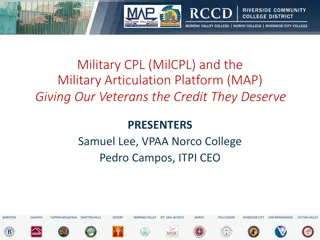ARTICULATION
Delve into the world of Computer-Supported Collaborative Work (CSCW) and the role of anthropology in understanding technology and social practice. Uncover key concepts like awareness, articulation work, and appropriation in group collaboration. Discover how technologies are shaped by their environments and the evolution of AI-based tools.
Download Presentation

Please find below an Image/Link to download the presentation.
The content on the website is provided AS IS for your information and personal use only. It may not be sold, licensed, or shared on other websites without obtaining consent from the author. Download presentation by click this link. If you encounter any issues during the download, it is possible that the publisher has removed the file from their server.
E N D
Presentation Transcript
ARTICULATION ARTICULATION JJanuary 15, 2024 Presenter: Dr. Laura Sikstrom
ARTICULATION ARTICULATION 1. To give clear and effective utterance 2. To put into words 3. To be jointed
Computer Supported Collaborative Work Computer Supported Collaborative Work (Grief 1988) (Grief 1988) Email WebEx InSite iCare/Connect Ontario/FirstNet System Digital whiteboards Smartphones Anything else? CSCW is an identifiable research field focused on understanding characteristics of interdependent group work with the objective of designing adequate computer-based technology to support such cooperative work. Essentially, CSCW goes beyond building technology itself and looks at how people work within groups and organizations, as well as the impacts of technology on those processes. CSCW has ushered in a great extent of melding between social scientists and computer scientists [Wikipedia, and ACM CSCW]
KEY CONCEPTS from CSCW KEY CONCEPTS from CSCW Awareness: individuals working together need to be able to gain some level of shared knowledge about each other's activities. (Dourish 1992; Reddy 2001) Some do not really know where the DASA comes from; It s a nursing thing maybe? I don t know anything about how nursing works. They document so much, I just filter it out. Articulation work: cooperating individuals must be able to partition work into units, divide it amongst themselves and, after the work is performed, reintegrate it.[7][8] Psychiatrists main role seems to be to reintegrate everything into a comprehensive narrative. Everything is in the impression FMTs rolled out in 2014 (with Gillian and Sara! Their first project together!) Appropriation (or tailorability): how an individual or group adapts a technology to their own particular situation; the technology may be appropriated in a manner completely unintended by the designers.[Dourish,2003]
Anthropology in/of CSCW Anthropology in/of CSCW Starting from the premise that technologies can be assessed only in their relations to the sites of their production and use, the authors reconstruct technologies as social practice. A central problem for the design of artifacts then becomes their relation to the environments of their intended use. - Lucy Suchman, 1980-Present (anthropologist and founder of HCI field) Q: What do developers of AI-based tools need to know about your work? A: The culture of the ED . A lot of emphasis on collegiality and there is a trusted team of staff who are considered more or less equal. - AI as discipline, floating signifier and PROJECT (that scales up practices of datafication) Computers are beginning to be seen not as tools, but as dialogue partners. May, 1991
Parallel Concepts/Approaches Parallel Concepts/Approaches Historical and Political Context: Post-Fordism/Late capitalism/neoliberalism (Ortner) Invention of the personal computer (Pfaffenberger) The fact that Google, after a search query, knows that I like avocado toast does not mean that I myself have now forgotten that I like it. To posit that this is the same type of dispossession as the sort that involves someone coming along and physically removing avocado toast from my plate is simply wrong. Methods: User research (UX) Institutional Ethnography (Dorothy Smith) Sociolinguistics (May) Actor-network theory (actants, hybrid collectif) Implementation science Ethnomethodology, Biography of Artifacts and Practices (Silvast 2023) -Evgeny Morozov As Ruha Benjamin shows, we ought to look not just at the racist impacts of data-driven technologies but at the social inputs which expose racialized bodies to extractive observation and make anti-Black surveillant technologies appear desirable and inevitable in the first place. (in Gray, 2021) Theoretical Frameworks: Articulation (Hall, Gramsci, Althusser) Governmentality (Foucault) Marxism (Accumulation by dispossession, Harvey) Data Dispossession Sociotechnical systems (STS) Interfaces (previous team meeting)
Articulation Articulation Althusser/Bourdieu?) /Bourdieu?) (Hall/Gramsci/ (Hall/Gramsci/Althusser Structures/Superstructures Structures = economic practice Superstructures = ideologies, politics Productive forces (machines and their productivity) Relations of production (humans and society) https://www.marxists.org/glossary/terms/althusser/index.htm
Articulation work is essentially the work that makes other work exist and possible makes other work exist and possible. - Synchronous and asynchronous work. - Work is articulated via EHRs, screens, paper, verbal communication (1:1 and group); - Policies/guidelines shaped by higher order work (e.g., nurse education, APN, manager, team lead). Note: we have not interviewed these staff. CSCW Matrix (1992)
Preamble: Preamble: As you know, this project examines the use of As you know, this project examines the use of electronic health record data to build machine learning electronic health record data to build machine learning models. So we have some questions about the models. So we have some questions about the documentation and retrieval of information about risk from documentation and retrieval of information about risk from the EHRs. Can you tell me a bit about your documentation the EHRs. Can you tell me a bit about your documentation practices? practices? How much time do you think you spend documenting information into the EHR? What does your interaction with the electronic health record (including FMT, various assessment tools) look like throughout a shift? (e.g. does it change throughout your shift?) When, why and how do you retrieve data from this record? What kinds of information are you looking for when you go into the electronic health record? Is there anything about the risk of violence or aggression that you look for specifically? What have you learned about electronic health record data from doing all this work? What do you think about the utility of this data for machine learning applications in mental health? What kinds of biases do you think might be embedded in this data? Spradley, J. 1980. Observation matrix from Participant Observation.
Fig 1: The loop of interaction Articulation work Articulation work: : cooperating individuals must be able to partition work into units, divide it amongst themselves and, after the work is performed, reintegrate it.[7][8] Reintegration = assessment/plan Other (n=1) Nurses Program Assistants (n=3) Psychiatrists Orders Obs (n=6) (n=2+) Obs/ Tasks Orders obs Collateral Social Workers Patients? (n=1) Other security guards, police, patient advocates, team lead, APN, nurse educator, pharmacists, manager, interpreters, janitorial staff, patients?
Question: Where does the patient fit into articulation work? They are assigned little agency in this process. Non-compliance , degrees of engagement Anything they say and do is fair game Police record/narrative of apprehensions supersede patient narratives (not fully) They are not collateral but police, family and friends are
Partition: Awareness is uneven Partition: Awareness is uneven I always look at the CTAS scores, the FMTS, talk to the nurse (C01 PGY5) FMTs? Never. Not once. I look at the physicians notes only. There are sooooooo many notes from nurses. I just go and ask the nurse if there is anything I need to know. (C11 PGY 3)
Dependence: Rules & Norms Dependence: Rules & Norms I need to make sure orders [meds, restraints] are there (e.g., culture = no verbal orders at CAMH) [Policies, interprofessional hierarchies, medico-legal obligations] Nurses will give me the scoop. [Trust] Nurses are amazing and always on it. I have never entered a situation where I felt like I wasn t prepped for what to expect. [TRUST] The residents on shift make or break a shift [described dangerous situation]. That [no one helpful] felt very unsafe to me. [DISTRUST. In theory, the multi-D should have everyone s notes in one place, but nurses are usually busy doing other things. [Outside Forces] I am required to provide care in a reasonable not optimal way. To give you an example, EMRs [enforce] a one size fits all approach. I end up taking the path of least resistance [checking box for PRNs], which means I end up not thinking about it that much . Actually formulating my own plan, makes me think about it. [C11 I m paraphrasing not exact quoting as this was a long convo]
Reintegration: The Multi Reintegration: The Multi- -D D [Interoperability, user requirements] [Interoperability, user requirements] I have to be able to tag it, etc. (c01, C06) Everything is in the impression. That s our disciplinary standard. (c11) The only advantage over EPIC [vs FirstNet] is that I can just write as above so that saves me some time. But I guess in EPIC I just copy and paste the other physicians note and say see below
Work Partitions & Risk Proximity Work Partitions & Risk Proximity Nurses TASKS PAs Psychiatrists Social Workers Other Total Number 32 62 120+ 4 ? Report to Manager (MG) Team Lead Medical Head? ? Variety (outside ED) Documentation Tasks PA Progress notes Storage room/belonging Strides? FMT Collateral Strides DASA/CIWA/CTAS/COWS Multi-D Bowels, Vitals, Meds Strides Multi-D (impression/plan) Powerforms (nurses too?) Order sets (restraints) Forms (1,2,3, 22, 59 etc.) Multi-D Social Worker Strides Discharge planning Unknown Person in crisis Care Tasks Basic needs (food) Change gowns Transitions Therapeutic convo Errands Reassurance Compassion Rounds (15 min) Restraints/Seclusion De-escalation Constants Cleaning Check ins Vitals Basic needs Therapeutic convo Patient flow/movement Meds Restraints/seclusion De-escalation Change gowns Assessments (30-60min per client, up to 12 per shift) Deescalation Restraints/seclusion Discharge planning Care coordination Housing/shelter De-escalation Variety/None Articulation Platforms Huddle/Handovers/FirstNet/BINDER with Sticky notes Whiteboard/Huddle/Hando vers/i-Care Rounds/Huddle/Whiteboard /Printout Rounds?/Huddle/whiteboar d/iCare/printout Email, 1:1 Doc/Care Ratio 10/90 60/40? 70/30 60/40? Variety Gender (M/F) 50/50? 60/40? 50/50? 10/90? ? Ethnicity/Race (White, other) 10/90? 30/70? 30/70? 70/30? ? Habitat Floor/outposts Care stations/floor Board room/Care Board Room/Care Back Back Room
Things we thought we knew, that remain true Things we thought we knew, that remain true Work is highly cooperative; staff value one another s contributions and seek consensus; this is likely unique to this particular ED setting. Safety first (in practice and documentation re. medico-legal obligations) Interpretation can place burdens on (racialized) staff (Participant C07) Utility of the DASA declines over time (eg., Nurses will give you the scoop C10) Gender shapes risk management practices ( Nurses like to call on the big guys Taboo behaviours (e.g, sexual violence) influence risk management practices
Things that surprised me Things that surprised me How much psychiatrists rely on nursing documentation (FMTs) to make their assessments (impression and plan in the Multi-D) How many people are reading the FMTs (not all, though, and verbal supersedes) How much information psychiatrists have access to (e.g, ConnectOntario) That not everyone is aware of what the DASA is or where it comes from (although in hindsight, this makes sense) How uncritical most people are of the data they are creating and sometimes using Participants use euphemisms to talk about racism (e.g, it s unpleasant but bottom line is that these people are very sick ) Everyone (so far) is very open to idea of using AI most cited chatGPT as part of the rationale for this opinion (e.g, motivation linked to reducing documentation burden)
Questions to Discuss Questions to Discuss I have been skipping question about personal experiences with violence, mostly due to time constraints. Thoughts? Dynamic and tox drug supply: flagged that it can shift from week to week. Unpredictable variable that we cannot measure. What are the opportunities for the text summarization project? Acuity index Is this a publication? If not, what would it need to become one?
SOME SOURCES SOME SOURCES Grief, Irene (ed.). 1988. Computer-supported cooperative work: A book of readings. San Mateo, CA: Morgan Kaufman. May, 1991. Sociolinguistic Research on Human-computer Interaction. https://journals.sagepub.com/doi/abs/10.1177/089443939100900402?casa_token=7p1H8UMZ17YAAAAA:yCt7ROWuo_tN- GQPmaP2n8HsiqqG2mnAbEB8Ktc8OINQfGa2NCAF6Fi0FKbwCzbA0Gv_pOS0qxin Harvey, D. 2017. The New Imperialism. Accumulation by Dispossession. https://www.taylorfrancis.com/chapters/edit/10.4324/9781315251196- 10/new-imperialism-accumulation-dispossession-david-harvey Grudin, 1994. CSCW History and focus. https://ieeexplore.ieee.org/abstract/document/291294?casa_token=TM_rans0D1sAAAAA:RoTvCU8HnrunHzcDHgOFwu99B1kklHmdW9k3vyWtqYJDov 13Q7sN53iCbkoJIecFNGadAf7I On Neoliberalism by Sherry Ortner: http://aotcpress.com/articles/neoliberalism/ Morozov, E. 2019. The Emperors New Clothes. https://thebaffler.com/latest/capitalisms-new-clothes-morozov Strauss, A. Work and the Division of Labour. https://www.tandfonline.com/doi/abs/10.1111/j.1533-8525.1985.tb00212.x Data Dispossesion (Sociociological Review): https://thesociologicalreview.org/magazine/may-2021/digital-social-life/data-dispossession/ Fuchs, 2023. A Marxist-humanist perspective on Stuart Halls communication theory. https://link.springer.com/article/10.1007/s11186-023-09524-5 Drazin. 2012. Design Anthropology. Design Anthropology: Working on, with and for Digital Technologies. https://www.taylorfrancis.com/chapters/edit/10.4324/9781003085201-17/design-anthropology-working-digital-technologies-adam-drazin Reddy et al.. 2001. Coordinating heterogeneous work. https://link.springer.com/chapter/10.1007/0-306-48019-0_13 Silvast et al. 2023. Theory-Methods Packages in STS. https://journals.sagepub.com/doi/epub/10.1177/01622439211040241 Dourish, 2003. https://link.springer.com/article/10.1023/A:1026149119426
Harvey on Neoliberalism Harvey offers a clear definition of neoliberalism as a system of accumulation by dispossession, which has four main pillars: 1) the privatization and commodification of public goods; 2) financialization, in which any kind of good (or bad) can be turned into an instrument of economic speculation; 3) the management and manipulation of crises (as above); and 4) state redistribution, in which the state becomes an agent of the upward redistribution of wealth (159-164 passim).

























